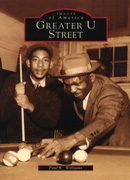Images of America: Greater U Street

Located at the very edge of the 1792 original city plan by city designer Pierre L'Enfant, the Greater U Street neighborhood of today served for nearly 70 years as orchards and grazing land for animals. However, with the settlement of Camp Campbell during the Civil War at where 6th and U Street is located today, the area quickly became home to thousands of fighting soldiers and then freed men and women. From this wartime beginning, thousands stayed in the area and began to construct small wood frame homes, churches, and businesses that eventually gave way to the elegant rows of substantial brick townhomes lining the surrounding street today.
However, with racial segregation increasing, the Greater U Street neighborhood became a "City within a City" for the African American community beginning in the 1910s, and lasting up to the urban riots of 1968. During the heyday of the 1920s and 1930s, the area thrived with world renowned entertainment venues such as the Howard, Dunbar, Republic, and Lincoln Theaters and private clubs like Bohemian Caverns hosting entertainers that included Sarah Vaughn, Pearl Bailey, Cab Calloway, and the neighborhood's own Edward "Duke" Ellington. Known by many as the "Black Broadway," the neighborhood was unique in that many of its institutions such as Industrial Bank and True Reformers Hall were designed, financed, owned, and built utilizing the talents of emerging African American professionals like banker John Whitelaw and architect John A. Lankford.